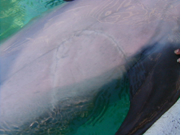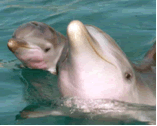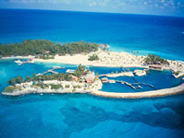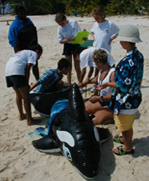Dolphin Myths and Facts
As marine mammal caretakers, we have learned a great deal about the needs of the animals under our care.
As educators, we share that knowledge with our guests daily. We nurture their desire to learn about the marvelous animals they come to see and touch.
Even so, many myths still reside in the media and the general public as to the lifestyle and care of these intriguing animals.
Take some time today to get the facts!!!
MYTH...
Dolphins in aquariums do not live as long as dolphins in the wild.
FACT...
Bottlenose dolphins under human care have a better chance of being healthy and studies indicate that they live as long or longer as animals in the wild. Any statement to the contrary is a misstatement of published data.
FACT...
The truth is that dolphins do very well when they are in the care of modern aquariums. They breed successfully, form complex social groups and exhibit excellent mental and physical health.
 Chippy shows off the shark bite that she
Chippy shows off the shark bite that she
was lucky to survive from while she lived
in the wild.
Dolphins under human care consume high-quality nutritional food, receive medical attention whenever needed and are kept free of debilitating parasites. This is in stark contrast to the predators, disease, pollution, well-documented commercial fishing and recreational dangers, and other stress they face at sea, resulting in thousands of deaths each year.
Today dolphins live long, healthy lives in aquariums because of medical advances made possible by public display. These advances have been essential in treating sick and injured wild animals as well as assisting and managing endangered species.
MYTH...
Dolphins cannot turn off their sonar and their own sonar is stressful to them in aquarium homes.
FACT...
Echolocation has been researched extensively and evidence clearly indicates that dolphins and whales can use their sonar at will, turning it on and off, and adjusting its intensity as needed.
FACT...
Dolphins use their sonar to produce sound and bounce it off objects which the animals then interpret. This echolocation is used to search for food, escape predators, navigate, stay with their pod, acoustically communicate with each other, and define the forms that make up their environment.
 A Bottle Nose Dolphin emitting sound and
A Bottle Nose Dolphin emitting sound and
'listening' to returning sounds.
Dolphins and whales can also fine tune their sonar, adjusting frequency and amplitude of their signals. They can also echolocate loudly, quietly or not at all, as they so choose. Dolphins do periodically go silent, especially while resting.
Studies with trained dolphins have been vital in understanding the nature of acoustic behavior. For example, it was found that dolphins can detect driftnets with their sonar. Ironically, the problem is to get dolphins to turn on their sonar to find and avoid these deadly nets.
MYTH...
Marine mammals are housed in enclosures of inappropriate size.
FACT...
Dolphin Encounter’s facilities meet and exceed standards for oceanariums, standards which assure that the animals have the ability to perform the full extent of their natural behaviors.
FACT…  Baby Goombay & his mom Dot
Baby Goombay & his mom Dot
The success of breeding programs internationally is another clear indicator that marine mammals live in enclosures of appropriate size as is longevity data which indicates that the lifespans of dolphins and whales is very similar and even exceeds those in the wild.
Some dolphins in the wild do swim vast distances, necessitated by their search for food, escape from predators and need for climates favorable for calving. Species like the bottlenose dolphin actually prefer protected and food-rich environs, leaving only for the purposes described above.
FACT...
Regardless of pool size, our dolphins voluntarily gate from one pool to the next. In fact, gating for a dolphin is primarily determined not by pool size but by who is in each pool concerned and what they get to do in that pool, play, toys, exercise, etc.
 Extensive Pool Facilities at
Extensive Pool Facilities at
Dolphin Encounters
In the Bahamas, the Department of Fisheries mandates pool sizes for dolphins to enable the animals to be comfortable, safe and healthy. The $4 million expansion of our facilities was done to meet the changing needs of our naturally growing dolphin pod.
MYTH...
Marine mammals in aquariums would adjust easily if released into the wild.
FACT...
Releasing an animal into the wild is a carefully made decision of which few marine mammals would make good candidates and even less would survive.
FACT...
The decision to release any marine mammal into the wild is based on three important factors; the animal’s health, the animal’s ability to survive, and the impact the animal will have on the wild population. Each decision must provide for the protection of both the released dolphin and for the ecological stability of the habitat selected for release.
 Kids learn how to assess and aid
Kids learn how to assess and aid
Willy the Whale in a mock-stranding
activity.
Marine Mammal experts believe that regardless of the level of preparation, less than one third of dolphins released survive the first year, and that for some programs, less than 1% survive at all.
Close to 1500 marine mammals have been successfully rescued, rehabilitated and released in the past five years through the efforts of voluntary stranding networks maintained throughout the U.S. by aquariums, zoos, and marine life parks. The success with stranded animals is not a valid argument for the release of animals in marine mammal facilities. The stranded animals were experienced at sea and capable of surviving when returned to the wild.
MYTH...
Training is only used to teach animals to perform tricks.
FACT...
Animal training is the foundation of marine mammal care upon which our relationship with the animals is built and the means to providing each animal with a long, healthy lifestyle.
FACT...
Participation by an animal in any training program, project or show is voluntary. Presentations such as programs at Dolphin Encounters demonstrate their physical capabilities, adaptation, ecological importance as well as how well the animals are cared for.

